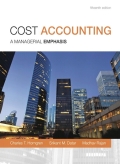
1.
To prepare: Graph for fixed manufacturing
Given information:
2014,
Budgeted fixed manufacturing overhead cost is $17,000,000.
Budgeted variable manufacturing overhead is $10 per machine hour.
The denominator level is $1,000,000 machine hours.
Budgeted fixed overhead cost per machine hour is
2.
(a)
Variable manufacturing overhead spending and efficiency variances.
Given information:
2014,
Budgeted hours allowed for actual output is 1,125,000.
Actual machine hours are 1,200,000.
Actual variable manufacturing overhead is $12,075,000.
(b)
Fixed manufacturing overhead spending and volume variances.
Given information:
2014,
Budgeted hours allowed for actual output is 1,125,000.
Actual machine hours are 1,200,000.
Actual fixed manufacturing overhead is $17,100,000.
Budgeted fixed overhead rate is $17 (calculated in part 1).
3.
The under or over allocated variable manufacturing overhead and the under or over allocated fixed manufacturing overhead and the reason for flexible
Given information:
2014,
Variable spending variance is $75,000 U (calculated in part B).
Variable efficiency variance is $750,000 U (calculated in part B).
Fixed spending variance is $100,000 U (calculated in part B).
Fixed volume variance is $340,000 F (calculated in part B).
Actual quantity of input used is 1,200,000 hours.
Actual rate is $10.0625.
Budgeted quantity for actual output is $1,125,000.
Budgeted rate is $10.
4.
The effect on the variances due to change in denominator.
Given information:
2014,
Budgeted hours allowed for actual output is 1,125,000.
Actual machine hours are 1,200,000.
Actual fixed manufacturing overhead is $17,100,000.
Denominator is 1,700,000
Budgeted fixed overhead rate is
Want to see the full answer?
Check out a sample textbook solution
Chapter 8 Solutions
Cost Accounting
- How much intrest bank collect?arrow_forwardRequired information Skip to question [The following information applies to the questions displayed below.]XYZ declared a $1 per share dividend on August 15. The date of record for the dividend was September 1 (the stock began selling ex-dividend on September 2). The dividend was paid on September 10. Ellis is a cash-method taxpayer. Determine if he must include the dividends in gross income under the following independent circumstances. b. Ellis bought 100 shares of XYZ stock on August 1 for $21 per share. Ellis sold his XYZ shares on September 5 for $23 per share. Ellis received the $100 dividend on September 10 (note that even though Ellis didn’t own the stock on September 10, he still received the dividend because he was the shareholder on the record date).arrow_forwardHow much overhead applied over this year?arrow_forward

 AccountingAccountingISBN:9781337272094Author:WARREN, Carl S., Reeve, James M., Duchac, Jonathan E.Publisher:Cengage Learning,
AccountingAccountingISBN:9781337272094Author:WARREN, Carl S., Reeve, James M., Duchac, Jonathan E.Publisher:Cengage Learning, Accounting Information SystemsAccountingISBN:9781337619202Author:Hall, James A.Publisher:Cengage Learning,
Accounting Information SystemsAccountingISBN:9781337619202Author:Hall, James A.Publisher:Cengage Learning, Horngren's Cost Accounting: A Managerial Emphasis...AccountingISBN:9780134475585Author:Srikant M. Datar, Madhav V. RajanPublisher:PEARSON
Horngren's Cost Accounting: A Managerial Emphasis...AccountingISBN:9780134475585Author:Srikant M. Datar, Madhav V. RajanPublisher:PEARSON Intermediate AccountingAccountingISBN:9781259722660Author:J. David Spiceland, Mark W. Nelson, Wayne M ThomasPublisher:McGraw-Hill Education
Intermediate AccountingAccountingISBN:9781259722660Author:J. David Spiceland, Mark W. Nelson, Wayne M ThomasPublisher:McGraw-Hill Education Financial and Managerial AccountingAccountingISBN:9781259726705Author:John J Wild, Ken W. Shaw, Barbara Chiappetta Fundamental Accounting PrinciplesPublisher:McGraw-Hill Education
Financial and Managerial AccountingAccountingISBN:9781259726705Author:John J Wild, Ken W. Shaw, Barbara Chiappetta Fundamental Accounting PrinciplesPublisher:McGraw-Hill Education





